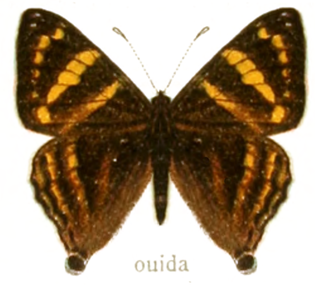Related Research Articles

Dodona ouida, the mixed Punch, is a small but striking butterfly found in the Indomalayan realm in West China, Himalayas, Northeast India (hills) and Burma that belongs to the Punches and Judies, that is, the family Riodinidae.

Miletus boisduvali, the common brownie, is a small but striking butterfly found in India and Myanmar that belongs to the lycaenids or blues family.

Miletus symethus, the great brownie, is a small butterfly found in India that belongs to the lycaenids or blues family. The species was first described by Pieter Cramer in 1777.

Azanus jesous, the African babul blue or topaz-spotted blue, is a small butterfly found in Africa, Egypt, Syria, India, Sri Lanka and Myanmar that belongs to the lycaenids or blues family.

Neopithecops zalmora, the Quaker, is a small butterfly found in South Asia and Southeast Asia that belongs to the lycaenids or blues family.

Hampson's hedge blue is a small butterfly found in Sri Lanka, south India, Myanmar, and Laos that belongs to the lycaenids or blues family.

The Indian fritillary is a species of butterfly of the nymphalid or brush-footed family. It is usually found from south and southeast Asia to Australia.
Garrha cylicotypa is a moth in the family Oecophoridae. It was described by Turner in 1946. It is found in Australia, where it has been recorded from Queensland.
Garrha interjecta is a moth in the family Oecophoridae. It was described by Turner in 1946. It is found in Australia, where it has been recorded from Queensland.
Garrha micromita is a moth in the family Oecophoridae. It was described by Turner in 1946. It is found in Australia, where it has been recorded from Queensland.
Garrha platyporphyra is a moth in the family Oecophoridae. It was described by Turner in 1946. It is found in Australia, where it has been recorded from Queensland.
Garrha pyrrhopasta is a moth in the family Oecophoridae. It was described by Turner in 1946. It is found in Australia, where it has been recorded from Queensland.
Garrha submissa is a moth in the family Oecophoridae. It was described by Turner in 1946. It is found in Australia, where it has been recorded from Queensland.
Garrha rubella is a moth in the family Oecophoridae. It was described by Turner in 1938. It is found in Australia, where it has been recorded from Tasmania.
Garrha mitescens is a moth in the family Oecophoridae. It was described by Edward Meyrick in 1914. It is found in Australia, where it has been recorded from Queensland and the Northern Territory.
Garrha agglomerata is a moth in the family Oecophoridae. It was described by Edward Meyrick in 1920. It is found in Australia, where it has been recorded from South Australia.
Garrha costimacula is a moth in the family Oecophoridae. It was described by Edward Meyrick in 1883. It is found in Australia, where it has been recorded from Queensland and New South Wales.
Garrha rufa is a moth in the family Oecophoridae. It was described by Edward Meyrick in 1883. It is found in Australia, where it has been recorded from New South Wales.
Garrha sericata is a moth in the family Oecophoridae. It was described by Edward Meyrick in 1883. It is found in Australia, where it has been recorded from Queensland and New South Wales.
Garrha pseudota is a moth in the family Oecophoridae. It was described by Oswald Bertram Lower in 1901. It is found in Australia, where it has been recorded from Queensland.
References
- ↑ Beccaloni, G.; Scoble, M.; Kitching, I.; Simonsen, T.; Robinson, G.; Pitkin, B.; Hine, A.; Lyal, C., eds. (2003). "Garrha rufescens". The Global Lepidoptera Names Index . Natural History Museum . Retrieved May 24, 2018.
- ↑ Garrha at funet
- ↑ Proc. Linn. Soc. N.S.W. 70 (3-4) : 108
| This article on a moth of the family Oecophoridae is a stub. You can help Wikipedia by expanding it. |